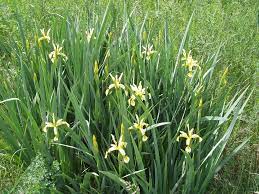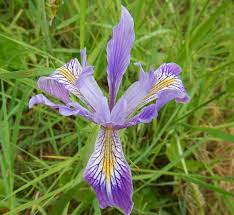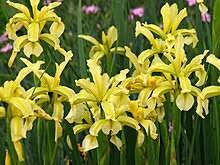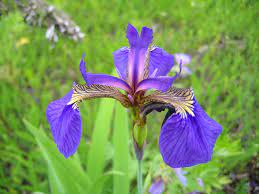Iris halophila, commonly known as the salt-loving iris, is a fascinating perennial plant that belongs to the Iridaceae family. Endemic to salt marshes and coastal areas, this iris is specifically adapted to thrive in saline environments, showcasing its remarkable resilience and ability to withstand challenging conditions.
The plant boasts slender, erect stems that can reach impressive heights, adorned with long, sword-shaped leaves. The leaves exhibit a distinctive blue-green hue, adding to the overall visual allure of Iris halophila.
The plant’s adaptive mechanisms enable it to efficiently manage the high salt concentrations in its habitat, a feat achieved through specialized physiological processes.
One of the standout features of Iris halophila is its striking flowers. The blooms, characterized by a mesmerizing blend of violet and lavender tones, create a captivating contrast against the backdrop of the saline landscape.
The intricate floral structure includes three upright outer petals, known as falls, and three inner, more upright petals, referred to as standards. This composition contributes to the overall elegance and aesthetic appeal of the plant.
During the flowering season, which typically occurs in late spring to early summer, Iris halophila attracts pollinators, such as bees and butterflies, with its vibrant and fragrant blossoms. The successful pollination process leads to the development of seed pods, ensuring the plant’s reproductive success.
Garden enthusiasts appreciate Iris halophila not only for its adaptability but also for its ornamental value. Cultivating this iris in coastal gardens or areas with saline soils adds a unique and resilient element to the landscape. As a testament to its hardiness, Iris halophila serves as a botanical marvel, showcasing nature’s ability to thrive in seemingly inhospitable conditions.
The Botanical Description of Iris halophila
1. Growth Habit: Iris halophila is a perennial herbaceous plant characterized by its upright growth habit and long, slender leaves.
2. Flower Structure: The flowers of Iris halophila are typically large and showy, with three upright petals called standards and three drooping petals called falls. These flowers come in various shades of blue, purple, or white, often with intricate patterns and markings.
3. Root System: This species of iris develops a fibrous root system that spreads horizontally in the soil, anchoring the plant and absorbing water and nutrients.
4. Stem: The stems of Iris halophila are typically sturdy and erect, rising from the base of the plant and supporting the flowers and foliage.
5. Leaf Arrangement: The leaves of Iris halophila are arranged in a basal rosette, emerging directly from the rootstock. They are long, narrow, and sword-shaped, with a prominent central vein.
6. Height: Depending on the growing conditions, Iris halophila can reach heights ranging from 30 to 60 centimeters (12 to 24 inches).
7. Reproductive Organs: Like other members of the genus Iris, Iris halophila reproduces via rhizomes, which are underground stems that produce new shoots and roots.
8. Habitat Preferences: This species is commonly found in coastal areas, marshes, and wetlands, where it thrives in moist, well-drained soils with high levels of organic matter.
9. Flowering Season: Iris halophila typically blooms in late spring to early summer, producing vibrant flowers that attract pollinators like bees and butterflies.
10. Adaptive Features: To survive in saline environments, Iris halophila has developed tolerance to high levels of salt in the soil, making it well-suited for coastal habitats.
11. Conservation Status: While not currently listed as endangered, Iris halophila may face threats from habitat loss and degradation due to coastal development and climate change.
12. Cultivation: Gardeners and horticulturists often cultivate Iris halophila for its ornamental value, selecting cultivars with desirable flower colors and patterns for landscaping purposes.
The Geographic Distribution of Iris halophila

1. Coastal Regions: Iris halophila is primarily distributed along coastal regions, including salt marshes, estuaries, and coastal wetlands.
2. Mediterranean Basin: This species is native to the Mediterranean Basin, where it can be found in countries such as Spain, France, Italy, Greece, and Turkey.
3. Western Asia: Iris halophila also occurs naturally in parts of Western Asia, including the Levant region and the Arabian Peninsula.
4. North Africa: In addition to its presence in the Mediterranean, Iris halophila extends into North Africa, where it is found in countries like Morocco, Algeria, and Tunisia.
5. Coastal Islands: This iris species may also inhabit coastal islands and archipelagos, where it colonizes sandy or rocky shores and salt marshes.
6. Temperate Climates: While Iris halophila prefers mild, maritime climates, it can tolerate a range of temperatures and soil conditions, allowing it to adapt to different coastal ecosystems.
7. Human Impact: Human activities such as urbanization, agriculture, and habitat destruction pose threats to the natural habitats of Iris halophila, leading to population declines in some areas.
8. Conservation Efforts: Conservation efforts aimed at preserving coastal habitats and restoring degraded ecosystems can help safeguard populations of Iris halophila and other coastal plant species.
9. Ecological Role: In its native range, Iris halophila plays a role in coastal ecosystems by stabilizing soil, providing habitat and food for wildlife, and contributing to biodiversity.
10. Distribution Challenges: Climate change and sea level rise pose additional challenges to the distribution of Iris halophila, potentially altering coastal habitats and threatening the survival of this species.
11. Research and Monitoring: Continued research and monitoring of Iris halophila populations are essential for understanding its distribution patterns, habitat requirements, and conservation needs.
The Chemical Composition of Iris halophila
1. Essential Oils: Iris halophila contains essential oils rich in compounds such as terpenes, phenols, and aldehydes, which contribute to its aromatic properties and potential therapeutic effects.
2. Flavonoids: Flavonoids are a group of polyphenolic compounds found in Iris halophila that possess antioxidant and anti-inflammatory properties, which may help protect against oxidative stress and inflammation-related diseases.
3. Alkaloids: Some species of Iris, including Iris halophila, produce alkaloids, nitrogen-containing organic compounds with diverse pharmacological activities, including analgesic, anti-inflammatory, and antimicrobial effects.
4. Tannins: Tannins are polyphenolic compounds found in Iris halophila that have astringent properties and may contribute to its traditional medicinal uses, such as wound healing and gastrointestinal relief.
5. Glycosides: Iris halophila contains glycosides, which are sugar molecules attached to other compounds, including flavonoids and alkaloids, enhancing their solubility and bioavailability in the body.
6. Saponins: Saponins are natural surfactants found in Iris halophila that have been investigated for their potential cholesterol-lowering, immunomodulatory, and anticancer activities.
7. Carotenoids: Carotenoids are pigments found in Iris halophila that contribute to the coloration of its flowers and may have antioxidant properties beneficial for human health.
8. Phenolic Acids: Phenolic acids are aromatic compounds found in Iris halophila that have antioxidant and anti-inflammatory properties, which may help protect against chronic diseases such as cardiovascular disorders and cancer.
9. Resins: Resins found in Iris halophila have been traditionally used for their antimicrobial properties and may have potential applications in natural medicine and pharmaceuticals.
10. Minerals: Iris halophila contains various minerals such as potassium, calcium, magnesium, and iron, which are essential for maintaining overall health and vitality.
11. Vitamins: Although present in small amounts, Iris halophila may contain vitamins such as vitamin C, vitamin E, and vitamin A, which play important roles in immune function, skin health, and vision.
12. Proteins: Iris halophila may contain proteins and amino acids necessary for cellular repair, growth, and metabolism, contributing to its nutritive value and potential health benefits.
13. Polysaccharides: Polysaccharides found in Iris halophila may have immunomodulatory effects, enhancing the body’s natural defense mechanisms and supporting immune function.
14. Lignans: Lignans are phytochemicals found in Iris halophila that have been studied for their potential anticancer and estrogenic activities, although more research is needed to elucidate their mechanisms of action.
Read Also: Rose Chafer: Description, Damages Caused, Control and Preventive Measures
The Medicinal Health Benefits Of Iris halophila (Salt-loving iris)

1. Anti-inflammatory Properties: Iris halophila has demonstrated anti-inflammatory properties, which may help alleviate symptoms of inflammatory conditions such as arthritis, rheumatism, and inflammatory bowel disease.
2. Antioxidant Activity: The presence of antioxidants in
Iris halophila may help neutralize free radicals and oxidative stress, reducing the risk of chronic diseases such as cardiovascular disease, cancer, and neurodegenerative disorders.
3. Wound Healing: Traditional uses of Iris halophila include wound healing and skin regeneration, attributed to its astringent and antimicrobial properties, which promote tissue repair and prevent infection.
4. Digestive Health: Iris halophila may support digestive health by soothing gastrointestinal inflammation, relieving indigestion and bloating, and promoting regularity and bowel function.
5. Respiratory Support: Herbal preparations of Iris halophila have been used to relieve respiratory symptoms such as coughs, congestion, and bronchial irritation, making it a potential remedy for respiratory conditions like asthma and bronchitis.
6. Immune Boosting: Some studies suggest that Iris halophila may possess immunomodulatory effects, enhancing the body’s immune response and defending against infections and diseases.
7. Stress Reduction: Iris halophila may have adaptogenic properties, helping the body cope with stress and promoting relaxation, mental clarity, and overall well-being.
8. Menstrual Relief: Traditional herbal remedies containing Iris halophila have been used to alleviate menstrual discomfort, including cramps, bloating, and mood swings, supporting women’s reproductive health.
9. Antimicrobial Activity: Iris halophila may exhibit antimicrobial activity against a range of bacteria, fungi, and viruses, making it a potential natural remedy for infections and skin conditions.
10. Liver Support: Some traditional uses of Iris halophila include liver detoxification and support, attributed to its purported ability to enhance liver function and promote the elimination of toxins from the body.
11. Cognitive Enhancement: Preliminary research suggests that Iris halophila may have cognitive-enhancing effects, improving memory, concentration, and mental clarity, although further studies are needed to confirm these findings.
12. Cardiovascular Health: Iris halophila may benefit cardiovascular health by lowering cholesterol levels, improving blood circulation, and supporting heart function, reducing the risk of heart disease and stroke.
13. Anti-allergic Properties: Some compounds found in Iris halophila may exhibit anti-allergic properties, helping to alleviate symptoms of allergies such as itching, sneezing, and nasal congestion.
14. Anticancer Potential: While more research is needed, preliminary studies suggest that Iris halophila may contain compounds with potential anticancer properties, inhibiting tumor growth and metastasis in experimental models.
15. Urinary Tract Health: Iris halophila has been traditionally used to support urinary tract health, reducing inflammation, preventing infections, and promoting urinary flow and kidney function.
16. Anti-diabetic Effects: Studies have suggested that Iris halophila may possess anti-diabetic effects, lowering blood sugar levels and improving insulin sensitivity, making it a potential adjunctive therapy for diabetes management.
17. Bone Health: The presence of minerals such as calcium and magnesium in Iris halophila may contribute to bone health, supporting bone density and strength, and reducing the risk of osteoporosis.
18. Skin Care: Iris halophila extracts may have skincare benefits, including moisturizing, soothing, and rejuvenating properties, enhancing skin health and appearance.
The Methods of Usage to Achieve the Provided Health Benefits Of Iris halophila (Salt-loving iris)
1. Herbal Tea: Prepare a decoction or infusion of dried Iris halophila leaves or roots to make a soothing herbal tea, which can be consumed daily to support overall health and well-being.
2. Tincture: Extract the active compounds of Iris halophila using alcohol or glycerin to create a concentrated tincture, which can be taken orally or added to water, juice, or tea for convenient dosing.
3. Poultice: Apply a poultice of mashed Iris halophila leaves or roots directly to the skin to relieve inflammation, promote wound healing, and soothe irritations such as insect bites and rashes.
4. Inhalation: Inhale the steam from a hot infusion or essential oil of Iris halophila to relieve respiratory congestion, coughs, and sinusitis, providing respiratory support and promoting clear breathing.
5. Capsules: Take standardized capsules or tablets containing Iris halophila extract as a convenient and precise way to benefit from its medicinal properties, particularly for conditions like digestive disorders and immune support.
6. External Wash: Prepare a diluted solution of Iris halophila extract to use as an external wash for cleansing wounds, treating acne, and soothing skin irritations, promoting skin health and healing.
7. Aromatherapy: Diffuse the essential oil of Iris halophila in a room diffuser or inhaler to create a calming and uplifting atmosphere, reducing stress, enhancing mood, and promoting relaxation.
8. Massage Oil: Dilute Iris halophila essential oil in a carrier oil such as coconut or jojoba oil to create a massage oil blend, which can be applied topically to relieve muscle tension, promote circulation, and support relaxation.
9. Compress: Soak a clean cloth in a diluted solution of Iris halophila extract and apply it as a warm or cold compress to areas of inflammation, pain, or swelling, providing localized relief and promoting healing.
10. Bath Soak: Add a few drops of Iris halophila essential oil or infused bath salts to a warm bath to create a soothing and aromatic bath soak, which can help relax muscles, relieve stress, and promote overall well-being.
11. Mouthwash: Prepare a diluted solution of Iris halophila extract to use as a natural mouthwash or gargle for oral hygiene, freshening breath, and soothing mouth and throat irritations.
12. Culinary Use: Incorporate dried Iris halophila leaves or roots into culinary recipes such as herbal teas, soups, stews, and salads to add flavor and potential health benefits to your diet.
The Side Effects Of Using Iris halophila Medicinal Plant
1. Allergic Reactions: Some individuals may experience allergic reactions to Iris halophila, particularly if they have allergies to other plants in the iris family or sensitive skin.
2. Gastrointestinal Upset: Consuming large doses of Iris halophila or its extracts may cause gastrointestinal upset, including nausea, vomiting, diarrhea, or abdominal cramps.
3. Skin Irritation: Applying concentrated Iris halophila preparations directly to the skin may cause skin irritation, redness, itching, or allergic dermatitis in sensitive individuals.
4. Photosensitivity: Certain compounds found in Iris halophila, such as furanocoumarins, may increase the skin’s sensitivity to sunlight, leading to sunburn or skin rashes with sun exposure.
5. Drug Interactions: Iris halophila may interact with certain medications, including blood thinners, antiplatelet drugs, and anticoagulants, potentially affecting blood clotting and increasing the risk of bleeding.
6. Pregnancy and Lactation: Pregnant or breastfeeding women should avoid using Iris halophila medicinally due to limited safety data and the potential risk of adverse effects on fetal development or nursing infants.
7. Liver Toxicity: In rare cases, excessive consumption of Iris halophila or its extracts may lead to liver toxicity or hepatotoxicity, particularly in susceptible individuals or with prolonged use.
8. Respiratory Effects: Inhalation of concentrated Iris halophila essential oil or vapors may irritate the respiratory tract and trigger coughing, wheezing, or breathing difficulties in sensitive individuals.
9. Central Nervous System Effects: Some people may experience central nervous system effects such as dizziness, headache, or confusion after using Iris halophila products, particularly if ingested or inhaled in large amounts.
10. Hormonal Effects: Certain compounds in Iris halophila may have hormonal effects, affecting hormone levels and menstrual cycles in women, although more research is needed to understand the mechanisms and potential risks.
11. Cardiovascular Effects: In rare cases, high doses of Iris halophila may affect cardiovascular function, leading to changes in blood pressure, heart rate, or rhythm, particularly in individuals with pre-existing heart conditions.
12. Renal Effects: Prolonged or excessive use of Iris halophila may potentially affect kidney function or exacerbate kidney disorders, particularly in individuals with underlying renal conditions or susceptibility.
13. Eye Irritation: Contact with Iris halophila sap or plant parts may cause eye irritation or conjunctivitis, leading to redness, itching, or inflammation of the eyes, especially if rubbed or touched inadvertently.
14. Digestive Discomfort: Some individuals may experience digestive discomfort or bloating after consuming Iris halophila preparations, particularly if they have underlying gastrointestinal conditions such as irritable bowel syndrome or gastritis.
Read Also: 12 Medicinal Health Benefits Of Ilex guayusa (Guayusa)
The Scientific Research and Studies of Iris halophila

1. Anti-inflammatory Activity: Research has demonstrated the anti-inflammatory activity of Iris halophila extracts, attributed to compounds such as flavonoids and alkaloids, which inhibit inflammatory mediators and pathways.
2. Antioxidant Properties: Studies have confirmed the antioxidant properties of Iris halophila, which help scavenge free radicals and reduce oxidative stress, protecting cells and tissues from damage and aging.
3. Antimicrobial Effects: Iris halophila extracts have shown antimicrobial effects against a range of bacteria, fungi, and viruses, suggesting potential applications in combating infections and microbial diseases.
4. Immunomodulatory Effects: Preliminary research suggests that Iris halophila may possess immunomodulatory effects, enhancing immune cell activity and cytokine production, which could benefit immune-related disorders.
5. Wound Healing Potential: Experimental studies have indicated the wound healing potential of Iris halophila preparations, promoting tissue regeneration, collagen synthesis, and epithelialization in animal models.
6. Pharmacological Activities: Pharmacological studies have identified various bioactive compounds in Iris halophila with pharmacological activities such as analgesic, antipyretic, diuretic, and hepatoprotective effects.
The Safety Precautions and Recommendations In Using Iris halophila Medicinal Plant
1. Consultation with Healthcare Provider: Before using Iris halophila medicinally, consult with a qualified healthcare provider, particularly if you have underlying medical conditions, are pregnant or breastfeeding, or are taking medications.
2. Dosage and Administration: Follow recommended dosage guidelines and administration methods when using Iris halophila products, avoiding excessive or prolonged use to minimize the risk of adverse effects.
3. Allergy Testing: Perform a patch test or allergy test before using concentrated Iris halophila preparations topically, particularly if you have sensitive skin or a history of plant allergies.
4. Sun Protection: If using Iris halophila preparations topically, apply sunscreen or protective clothing to exposed skin to reduce the risk of photosensitivity reactions in sunlight.
5. Monitoring for Adverse Effects: Monitor for any adverse effects or reactions when using Iris halophila products, such as gastrointestinal discomfort, skin irritation, or respiratory symptoms, and discontinue use if necessary.
6. Storage and Handling: Store Iris halophila products in a cool, dry place away from direct sunlight and moisture, and keep them out of reach of children and pets to prevent accidental ingestion or contact.
7. Quality and Purity: Ensure that Iris halophila products are obtained from reputable sources and are of high quality and purity, free from contaminants, adulterants, or harmful substances.
8. Discontinue Use: Discontinue use of Iris halophila products if you experience any adverse effects, allergic reactions, or unexpected symptoms, and seek medical attention if necessary.
9. Pregnancy and Lactation: Pregnant or breastfeeding women should avoid using Iris halophila medicinally unless under the guidance and supervision of a qualified healthcare provider due to potential risks to maternal and fetal health.
10. Interaction with Medications: Be aware of potential interactions between Iris halophila and medications, particularly blood thinners, anticoagulants, or medications metabolized by the liver, and consult with a healthcare provider if necessary.
11. Adherence to Guidelines: Adhere to relevant guidelines, regulations, and recommendations regarding the cultivation, harvest, preparation, and use of Iris halophila for medicinal purposes to ensure safety and efficacy.
12. Education and Awareness: Educate yourself about the potential benefits, risks, and precautions associated with using Iris halophila medicinally, and seek professional advice or guidance as needed to make informed decisions about its use.
13. Reporting of Adverse Events: Report any adverse events, side effects, or safety concerns associated with the use of Iris halophila products to appropriate regulatory authorities or healthcare professionals for further evaluation and investigation.
14. Sustainable Harvesting Practices: Practice sustainable harvesting and cultivation techniques to ensure the long-term viability and conservation of Iris halophila populations and their natural habitats.
FAQs About Iris halophila Medicinal Plant
1. What is Iris halophila and its common name?
Iris halophila, commonly known as the Salt-loving Iris, is a perennial herbaceous plant native to coastal regions of the Mediterranean Basin and Western Asia.
2. What are the traditional medicinal uses of Iris halophila?
Traditional medicinal uses of Iris halophila include wound healing, respiratory support, digestive relief, immune boosting, and menstrual relief, among others.
3. How is Iris halophila typically prepared for medicinal use?
Iris halophila can be prepared for medicinal use in various forms, including herbal teas, tinctures, poultices, capsules, essential oils, and topical preparations.
4. Are there any known side effects or risks associated with using Iris halophila medicinally?
While generally considered safe when used appropriately, Iris halophila may cause side effects such as allergic reactions, gastrointestinal upset, skin irritation, and photosensitivity in some individuals.
5. Can Iris halophila interact with medications or other herbs?
Yes, Iris halophila may interact with certain medications, particularly blood thinners, anticoagulants, and drugs metabolized by the liver, as well as other herbs or supplements with similar pharmacological effects.
6. Is Iris halophila safe for use during pregnancy or lactation?
Pregnant or breastfeeding women should avoid using Iris halophila medicinally due to limited safety data and the potential risk of adverse effects on maternal and fetal health.
7. How should Iris halophila products be stored and handled?
Iris halophila products should be stored in a cool, dry place away from sunlight and moisture, and handled with care to prevent contamination or accidental ingestion.
8. Can I grow Iris halophila at home for medicinal purposes?
Yes, Iris halophila can be grown at home in suitable climates or conditions, provided that it receives adequate sunlight, water, and well-drained soil.
9. Where can I find Iris halophila products for purchase?
Iris halophila products, including dried leaves, roots, extracts, and supplements, may be available for purchase at health food stores, herbal dispensaries, online retailers, and specialty pharmacies.
10. How can I ensure the quality and authenticity of Iris halophila products?
To ensure quality and authenticity, purchase Iris halophila products from reputable sources that adhere to strict quality control standards, purity testing, and ethical harvesting practices.
11. Can I use Iris halophila products for pets or animals?
While some herbal remedies containing Iris halophila may be used for pets or animals under veterinary supervision, it’s essential to consult with a qualified veterinarian before administering any herbal products to pets.
12. Are there any regulations or guidelines for the sale and use of Iris halophila products?
Regulations and guidelines regarding the sale and use of Iris halophila products may vary by country or region, so it’s important to familiarize yourself with local laws and regulations governing herbal medicines and supplements.
13. How long does it take to experience the health benefits of Iris halophila?
The time it takes to experience the health benefits of Iris halophila may vary depending on factors such as dosage, frequency of use, individual response, and the specific health condition being addressed.
14. Can Iris halophila be used in combination with other herbs or supplements?
Yes, Iris halophila may be used in combination with other herbs or supplements to enhance its therapeutic effects or address specific health concerns, although it’s advisable to consult with a healthcare provider or herbalist for personalized recommendations.
15. Are there any contraindications or precautions for using Iris halophila?
Individuals with known allergies to plants in the iris family, as well as those with certain medical conditions or taking specific medications, should exercise caution or avoid using Iris halophila medicinally without consulting a healthcare professional.
16. How can I report adverse reactions or side effects associated with Iris halophila products?
If you experience any adverse reactions or side effects after using Iris halophila products, you can report them to relevant regulatory authorities, healthcare providers, or consumer safety agencies for further investigation and monitoring.
Read Also: How To Raise Chickens – The Simple Secrets To A Great Backyard Flock

